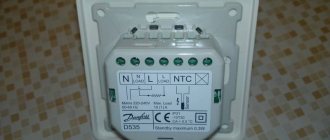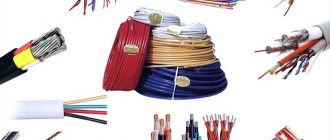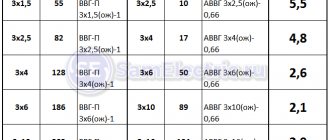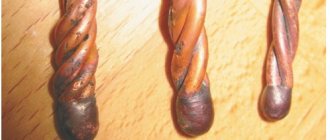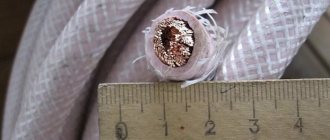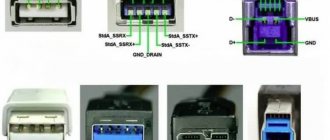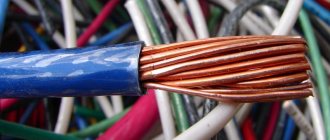SIP wire stands for self-supporting insulated wire. This type of wiring was developed in the 60s in Finland. The main area of application is the creation of main power lines, branches from main power lines, arrangement of connections to buildings and transformer booths.
Various modifications of SIP can be used for lighting if the composition contains lighting wires.
SIP cable comes in several types: SIP-1, SIP-2, SIP-3, etc. Each variety has special technical characteristics and scope of application.
Construction and classification
The cable design assumes the presence of insulated conductors of a set shape and cross-section, one of which is not used to transmit current, but serves as a carrier string.
The following brands are distinguished, designated by this number after the abbreviation SIP:
- 1 – of four cores of their mutually twisted conductors, three of which are phase, one is neutral. The phase taps are insulated, unlike the neutral tap, which is made of steel. If the marking contains the letter A, this indicates the presence of insulation at the zero line;
- 2 – a similar design, differing in the insulation of the neutral wire. Typically, thermoplastic polyethylene is used to insulate the zero terminal, but sometimes, in products with the letter A in the designation, thermoplastic material is used. This option is used when operating under aggressive weather conditions. Like the previous version, it is used on lines with voltage within 1 kV;
- 3 – version with a single-core design for a current-carrying element. In the center there is a steel core, around which aluminum wires are wound. Designed for use when laying high-voltage lines from 6 to 35 kV at large distances between points;
- 4 – pair combination with equivalent wires, without neutral and carrier. Not suitable for overhead lines as it is not designed to withstand high tensile loads;
- 5 is an analogue of the previous version, with more resistant insulation at an increased temperature threshold.
Also read: Technical characteristics of the wire - PVA
More details about the design of a particular type of cable can be found in the symbol and technical description from the manufacturer.
Main area of use
SIP wires are used for the following purposes:
- creation of branches from the main power line;
- laying lighting lines;
- connecting power lines to the transformer box;
- connection of country houses, industrial and public facilities, residential buildings;
- laying wiring along the walls of buildings.
The conditions for using the wire depend on the specific marking. SIP with additional sealing can be used in conditions of high humidity, including in tropical areas, near large artificial or natural reservoirs and bays.
Products with an insulated neutral wire are suitable for use in environments with high salt content, i.e. in coastal cities, near salt marshes or the ocean coast.
Insulated wires have almost completely replaced their predecessor. SIPs are widely used in developed countries, tropical countries, and northern regions.
Important! Wiring on average can withstand temperature changes from -20 to +70 degrees, so it is suitable for use in a wide variety of weather and climatic conditions.
Specifications
The SIP cable has the following technical characteristics:
- number of veins - from one to four;
- cross-sectional area – from 16 to 240 sq. mm, depending on the model;
- voltage class – up to 1 or 35 kV;
- temperature regime - a normal value of ambient temperature that allows normal operation of the product;
- the permissibility of short-term heating - characteristic of an emergency situation, up to 8 hours throughout the year;
- bending radius - allowing the wire to deform.
Technical data of SIP cable
Electrical characteristics of SIP cable insulation
Electrical resistance of the conductor
The listed characteristics vary depending on the brand of product.
Average cost of products
The cost of the cable depends on its type, as well as the manufacturer. Regional enterprises set lower prices, metropolitan companies sell goods at inflated prices. It is most profitable to purchase SIP from Ural enterprises.
Average prices for Moscow:
- SIP-1 – 20 rubles per meter;
- SIP-2 – 25 rubles per meter;
- SIP-3 – from 50 to 75 rubles;
- SIP-4 – from 35 to 90 rubles.
Cable wiring can be done by both professionals and amateurs. Wires with an insulating layer cannot give an electric shock, and a simple algorithm for attaching the fittings further facilitates the process. The only difficulty is the large weight of SIP with a cross section of 50 mm (3-4 kg per 10 m).
Application, advantages and disadvantages
The presence of an insulating coating ensures high performance and a wide range of applications for these products. Most often, this material is used to supply energy to homes, connect facilities at industrial enterprises, and connect consumers.
Compared to other material options, SIP has the following advantages:
- lower value of reactive losses;
- lack of use of additional insulating elements on supports;
- greater compactness due to the multi-core design;
- protection against corrosion due to the presence of an insulating coating;
- no risk of short circuiting in strong winds;
- difficulty of unauthorized connection.
Disadvantages - significant mass per linear meter, with the need to reduce the distance between supports and the need for additional protection when used in premises of special hazard categories.
Installation work
Installation of any SIP system does not require a large time resource. The wire is easy to connect on your own. But its connection with other elements of the power grid requires approval from the government service. Before introducing the cable into the house, the user is required to obtain the appropriate agreement from the energy supplier.
You might be interested in Cable VVGng A LS: decoding of markings and characteristics
Cable installation steps:
- Selection of section. For everyday use, a cable with a cross-section of 15 mm is most often used.
- If it is necessary to branch off from the main line, a clamp is used. He performs punctures on the post. The advantage of using clamps is that there is no need to protect the cable. The tips are installed immediately.
- To make the transition from the network to the house, the distance between which is more than 25 m, install a support with a tensioner.
- Availability of fasteners.
- An anchor type clamp is mounted on the external wall of the house where the output is planned. It is presented in the form of fittings with a bracket. A prerequisite is the same number of phases and terminals used.
- A wooden house requires additional wire insulation. In other cases it is left open. If the cable is introduced into the house, it is branched inside into rooms. A coupling can be used to connect the product.
For electrical installation work, experts recommend using SIP cable. It is laid out quickly. There is no need to use heavy and complex equipment. To carry out work at height, you will need the help of a qualified electrician.
Packaging, storage and transportation of SIP
In accordance with regulatory requirements, these products are transported wound on drums. Sometimes the cable can be transported and stored in coils, if we are talking about a small quantity, within 25 kg with a cross-section of the main wire from 16 to 25 square meters. mm.
Also read: Technical characteristics of the cable - MKESH
The material must be stored in a covered shed or enclosed area. Outdoor storage is allowed for a short period of time.
A passport tag is attached to the drum, protected by waterproof packaging.
Installation of insulators at overhead lines
When all the supports are exposed, you can begin installing insulators on them. Moreover, here you can use both traditional porcelain insulators ШФ-20, and insulators of the new generation IF27 with a special plastic sleeve.
IF27 is more convenient to install and allows you to roll out SIP-3 wire without the presence of mounting rollers. Insulators are mounted on traverse pins or on support hooks using plastic caps KP-22.
However, it is not necessary to use modern brands of insulators everywhere. For example, on anchor supports for VLZ lines with SIP-3, the old time-tested glass insulators PS-70E, collected in garlands of at least 2 pieces, have proven themselves very well.
Technical characteristics of insulators from Ensto, Sicam, Niled for SIP-3:
EnstoSicamNiled
After installing the insulators, they begin to roll out the wires. The easiest way is to roll out and install directly along the grooves of the IF27 pin insulators.
If simple ShF-20 insulators are used, then you will need unrolling rollers, which must be installed on the cross-beams of the intermediate supports.
How to choose a cable
The cable is selected taking into account the conditions of intended use, based on the brand and cross-section of the current-carrying wire. Integrity is checked with a multimeter in the following order:
- The device is placed in the “dialing” position. The serviceability of the multimeter is checked by connecting the contacts. With the appropriate signal, you can begin checking;
- Each wire is checked with probes - with different contacts attached to individual ends of the wire. The signal indicates that there is no damage.
It is not recommended to start laying the cable without first ensuring its integrity.
Laying conditions
Cable laying does not require special qualifications. In the process of performing such work, special supports or structural elements of buildings can be used.
It is easier to consider the laying conditions using the example of its placement on reinforced concrete supports:
- the safety of the insulating coating is ensured by special plastic rollers or thimbles that allow unimpeded movement of the cable;
- the wire must not be dragged along the ground or tree branches, so as not to damage the insulation;
- before mounting on the support, the cable is pulled through the movable device and fixed;
- You cannot wind two or more wires together when laying them together.
Fastening the SIP on the support and supplying it to the meter on the support List of materials required for installation of the unit:
- Mounting tape – F 207.
- Clamp - A 20.
- Intermediate suspension kit – ES 1500.
- Sealed piercing clamp FIDOS 4-35/6-150 – RS 35-150.
- 2x Adapter for clamp PC 35-150 – F 2.
- Anchor brackets – CA 1500/2000.
- Anchor clamp for wires of subscriber branches - RA 25.
- Measuring and distribution cabinet made of polyester 320x665x235 - MRO 1-S.
The absence of errors when performing work will eliminate the need for subsequent revisions and repairs.
Also read: Cable Specifications – NYM
Cable termination
Tips for choosing
To buy a suitable wire, it is recommended to take into account the basic parameters, including the cross-section (4x16, 2x16, 4x50, 4x25, 4x35). This parameter is considered the main one when it is necessary to extend the cable. Wires are classified according to technical properties into the following types:
- SIP-1. The cores are covered with polyethylene.
- SIPT-2 and SIPT-1A. Contains only isolated threads.
- SIP-2. All cores, except the zero wire, are insulated and molecularly connected.
- SIP-2A. All components of the core are covered with molecular polyethylene.
- SIP-3. It is recommended to check for certification before using this brand. More often the wire is used at home. It is made of 1 core, presented in the form of dense aluminum with polyethylene.
- SIP-4. The neutral core is missing.
- SIP-5. The cable is used in enterprises or for installation of electrical networks in cities. The production of products is very complex, since a polyethylene coating is provided. Each thread is wrapped in its own sheath.
Brands SIP-4 and SIP-5 consist of 2 or more threads. The wire marking includes the date of its manufacture, batch number, and other information from the manufacturing company.
